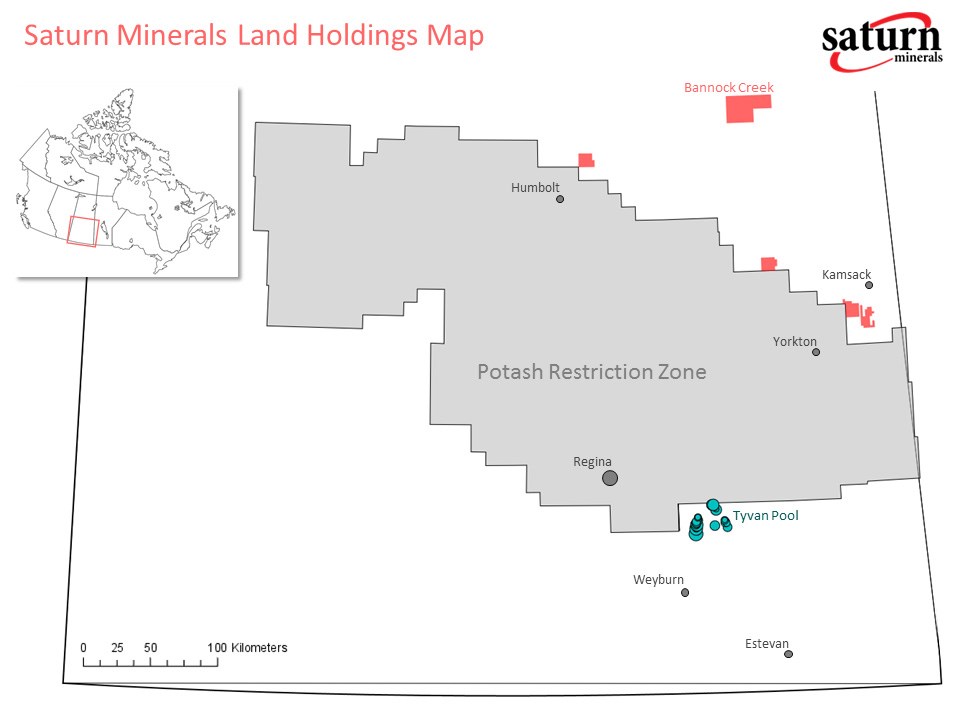Kamsack, Rama, Humboldt– After problems with an earlier well they had drilled, in March Saturn Minerals Inc. was finally successful in drilling and coring a well southwest of Hudson Bay, Sask. That well was on a property they call Bannock Creek.
The company said they had found oil, but promptly enacted its rights to keep details private under “tight hole” allowances. But the company moved pretty quickly after that.
By June it put in bids for four blocks of land, roughly 10,000 hectares each, for the August Crown lands sale. They were successful in that sale, and announced the details of those special exploration permits on Aug. 16.
The acquisition includes 158 sections (41,000 hectares or 410 square kilometres of oil and gas special exploration permits. The four blocks, in addition to the Bannock Creek property, map out what Saturn is calling the “oil triangle.”
Each block is roughly the size of a township, with the extreme southeast one С����Ƶ somewhat irregular. The new blocks run in a line running in a north-by-northwest line from south of Kamsack to north of Humbolt, each closely hugging the potash restriction zone. That zone, established by the provincial government, reserved a broad band of central Saskatchewan for potash development only. It does not allow oil development, since wells penetrating underground mines can be disastrous.
The oil triangle Saturn has staked out is roughly the same size as the oil-producing area of southeast Saskatchewan, which falls south of the potash restriction zone.
In the southeast corner, two blocks lie adjacent to each other, south and southeast of Kamsack. (Kamsack had operational natural gas wells in the early 1900s). The middle block is close to Rama. The western-most block is northeast of Humboldt and south of St. Brieux.
Stan Szary, president and CEO of Saturn, spoke to Pipeline News on Aug. 17 about the developments.
While it is still too soon to talk about the details of what was found at Bannock Creek, he did point out something mentioned in their press release the day before – what he considers the biggest news – the oil they found is sourced locally. In other words, the source rock for the oil they found is produced in the region, as opposed to the well-known “kitchen” in the Williston area of northwest North Dakota.
“It’s locally sourced,” he said.
A geological “kitchen” generally has to be deep enough and hot enough to produce oil. The depths in that area aren’t anywhere close to what is in North Dakota, but Szary said there is “a strange amount of geothermal.” Thus, Saturn thinks there could be source rock close enough that it is trapped locally.
Saturn’s exploration model hinges on Ordovician Red River source rock with large structural traps north of the Potash Restriction Zone, in their oil triangle.
“That is what we are basing our model on,” he said. “We now know the source rock is local.”
This was identified by the level of total organic carbon, which he explained tells you how good your source rock is. Those numbers, he said, are really high.
This would be a conventional play, Szary added, not requiring fracking.
The primary target formation of Saturn Minerals exploration program continues to be the Red River Formation, a stratigraphic unit of Upper Ordovician age in the Williston Basin well known for economic pools of oil south of the Potash Restriction Zone, and unexplored north of the Potash Restriction Zone. The analogous oil pool model to the south that Saturn is targeting is the Red River Tyvan pool which contains an estimated 60 million barrels in place with 15 million recoverable barrels of light crude 31 API oil.
It’s no coincidence their exploration blocks are adjacent to the potash zone. Szary thinks there’s oil in that area, too, if only it could be developed. He pointed out that if the potash zone extended into southwest Manitoba, it would include areas that currently have light oil development. An example would be as Crescent Point Energy Corp.’s field near Kirkella, Man.
“If the government were to open parts of the potash restriction zone, you’d see a massive stampede (of oil exploration) in there,” he said, adding there’s “no question” of oil in the restriction zone.
Their Bannock Creek property was the highest risk area of their oil triangle, he noted. In Szary’s opinion, there’s as much oil north of the zone as there is south, it just has to be proven.
To that end, Saturn will be conducting aerial surveys of their blocks to identify areas for seismic surveys. They intend on drilling on at least two of the new blocks, hopefully between Christmas this year and the end of March 2017. They are also looking at another well on the Bannock Creek property.




